Category: Food
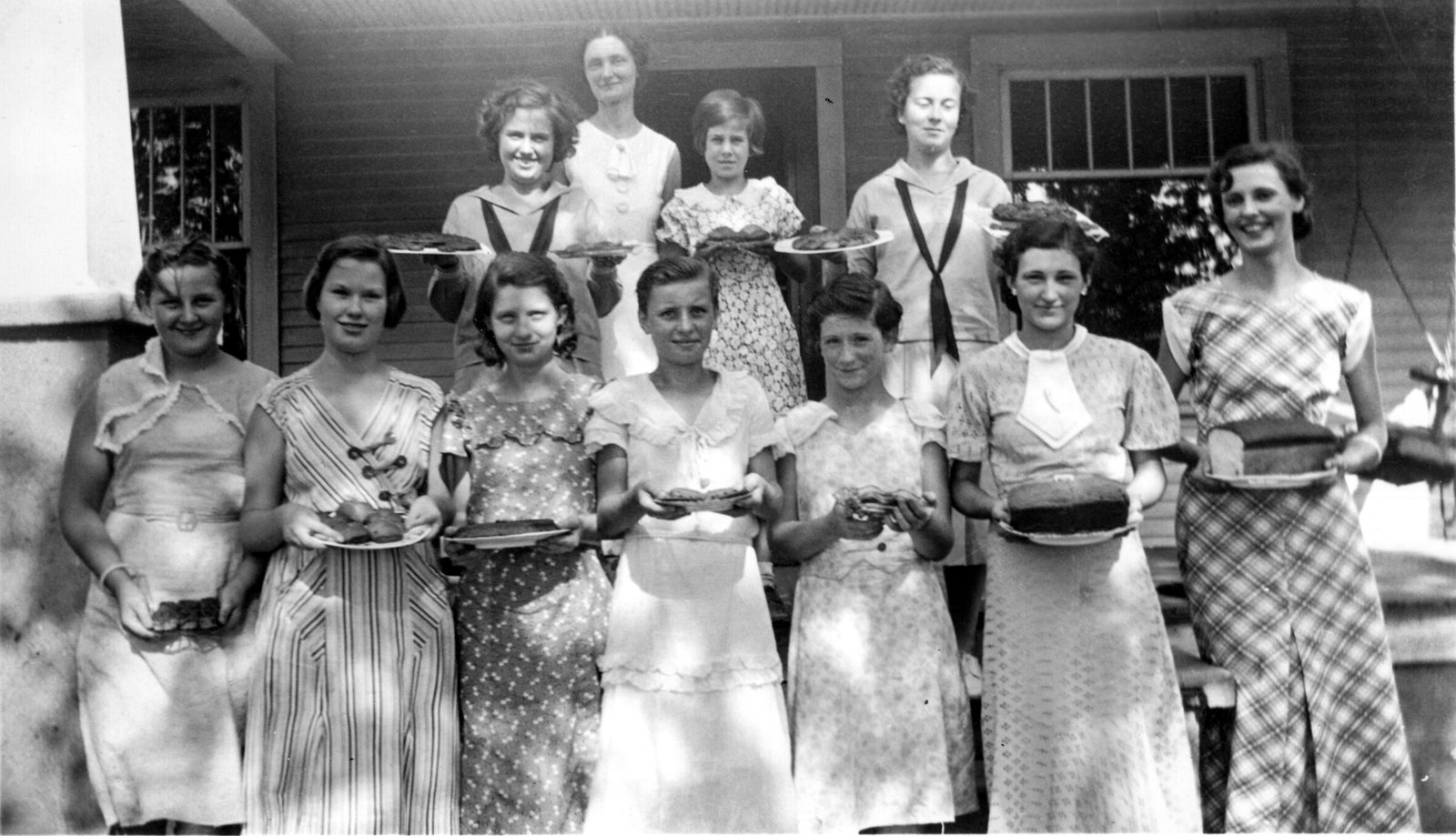
Growing with Grow: Iowa 4-H Leader Guides 100-Year-Old 4-H Club for 50 Years
With more than 50 years of experience leading the century-old Sugar Grove Sunshine 4-H Club in Dallas County, Iowa, Lorna Grow knows what it takes to help kids succeed. It doesn’t mean giving everyone a participation ribbon.
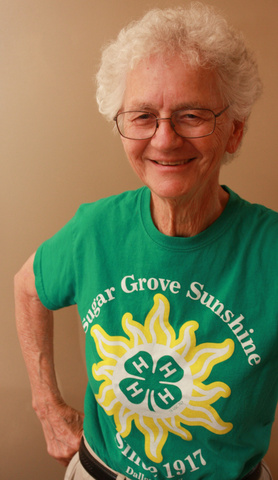
Lorna Grow has led the Sugar Grove Sunshine 4-H Club near Dallas Center, Iowa, since 1966.
“You gain confidence when you achieve,” said Grow, 84, a retired teacher who has guided Sugar Grove Sunshine 4-Hers since 1966 when her oldest daughter, Glenace, joined the club. “I expect high-quality work from my 4-H kids, and I coach them to help them learn.”
With her high-energy style, quick smile and lively personality, Grow is a hands-on instructor, whether she’s helping the kids refinish furniture, re-cane vintage chairs, bake a pie from scratch, sew on a button, hem pants, sew flannel-lined, zippered gun cases or complete basic home repairs like fixing a hole in the wall. While she coordinates 30- to 45-minute educational workshops that are held during the club’s meetings on the first Monday evening of the month, Grow doesn’t stop there.
“Because I’m retired, I can devote additional time for extra activities,” said Grow, a great-grandmother who marches in local parades with her 4-Hers, helps her club sponsor a county-wide cooking challenge for 4-Hers and their friends, inspires 4-Hers in design-a-room competitions, works with them throughout the Dallas County Fair and supports them at the Iowa State Fair.
Whenever there’s a local 4-H activity going on, Grow is there, said Aleta Cochran, county youth coordinator for Dallas County Extension. “The kids love Lorna. She always supports the kids, listens to them, encourages them and helps them grow.”
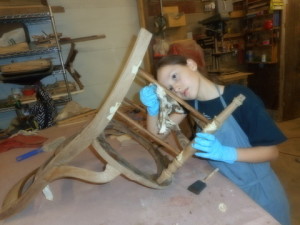
Refinishing furniture and chair caning offer Sugar Grove Sunshine 4-H Club members like Isabel Simpson the chance to learn skills they may not learn anywhere else.
A century of believing, a future of achieving
Grow has been involved with 4-H since 1943, when she joined the Union Lassies 4-H Club in Indianola. The all-girls club followed the traditional three-year program rotation of food, clothing and home improvement.
The club that Grow would become most affiliated with, however, is the Sugar Grove Sunshine 4-H Club in Dallas County. This group dates back to 1917, when a 4-H club led by Mrs. A.J. (Mary) Hayes was founded at Sugar Grove No. 9, a one-room country school near Dallas Center. This 4-H sewing club had 10 members, met weekly and wore blue uniforms with white caps. The entire club traveled to the Iowa State Fair by car (quite an outing in those days) and marched in the state fair parade behind the 168th Infantry.
The club evolved in 1922 into the Oblegro (Observe, Learn, Grow) Club. After an A.B.C. Club was organized in 1929, the two clubs joined and eventually became the Sugar Grove Sunshine 4-H Club, named after the local township. From 1918 through about 1965, the Dallas County Farm Bureau sponsored local 4-H clubs, which were separated into girls’ clubs and boys’ clubs.
“We are the oldest documented 4-H club in Dallas County,” said Grow, who added that 4-H clubs began to integrate in the 1990s. “I think the club’s founders would be surprised their group is still going all these years later when so many other 4-H clubs have died out.”
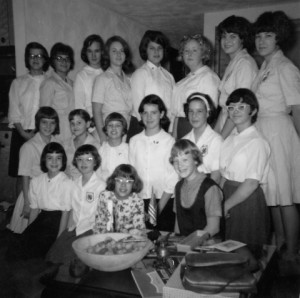
Sugar Grove Sunshine 4-H Club members, 1966-67
Today, the Sugar Grove Sunshine 4-H Club includes 42 boys and girls in grades 4 through 12 from Dallas Center, Adel, Van Meter, DeSoto, Perry, Grimes, Johnston and Urbandale. While it can be challenging for kids to find time for 4-H, due to busy schedules packed with sports, dance lessons and more, Grow refuses to schedule meetings on Sundays. “That’s family time,” she said.
Families are the key to success with any 4-H activity, she added. “I have wonderful 4-H kids because I have wonderful parents who care about their kids.”
Learning skills for life
These parents value the life lessons that 4-H teaches, including decision-making skills, goal setting, leadership and teamwork. To enhance the learning, Grow assigns older 4-Hers to help mentor younger club members.
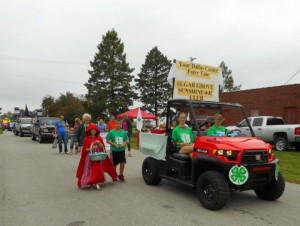
Members of the Sugar Grove Sunshine 4-H Club, along with club leader Lorna Grow, represented 4-H in this 2015 parade.
The Sugar Grove Sunshine 4-H members have also gained a new appreciation for history by helping plan the club’s 100-year-anniversary celebration, which was held Sept. 24, 2016, at the iconic Lake Robbins Ballroom near Woodward.
During the program, club members performed some of the songs that earlier generations of 4-Hers enjoyed from the 4-H Song Book. “The emphasis on music back then reflected people’s desire to get more culture into the rural areas,” said Grow, who added that the Adel Live Wires 4-H Club had an orchestra at one time.
Club members also researched local 4-H club record books dating back to the 1930s, when club projects included altering dress patterns and answering roll-call questions like “my favorite radio program.” Club members also scanned photos of previous generations of 4-Hers, including a group of girls showing off their baked goods for the 1934 Achievement Day. “Back then, you had to go through Achievement Day to have your project qualify for the Dallas County Fair,” Grow said.
While those early 4-H members used to meet in club members’ homes, today’s Sugar Grove Sunshine 4-H members meet in the basement of the Dallas Center Church of the Brethren. They also gather once a year at the Dallas Center-Grimes school to cook a meal and host an appreciation dinner for parents and guests. “We’ve served everything from Mexican to Chinese and prepare a four-course meal, including appetizers,” Grow said.
The learning opportunities that Grow offers 4-Hers are exceptional, emphasized Cochran with Dallas County Extension. “Lorna has done so much for 4-H. A volunteer like her is priceless.”
Grow said she’ll continue to serve as a club leader until she’s no longer effective. “Why do I keep doing this? Because I’m having fun. I love watching these kids grow and develop skills that will benefit them throughout their life.”
P.S. Thanks for joining me. I’m glad you’re here.
@Copyright 2017 Darcy Maulsby & Co.
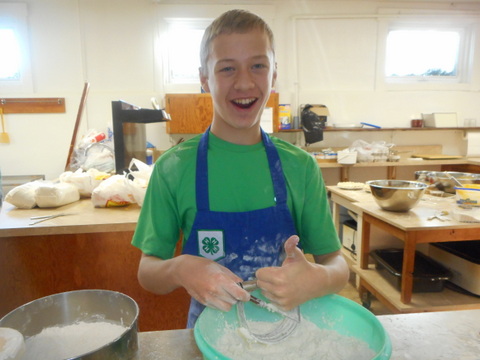
Members of the Sugar Grove Sunshine 4-H Club, like Jacob Storey, enjoy hands-on learning for pie baking and other skills.
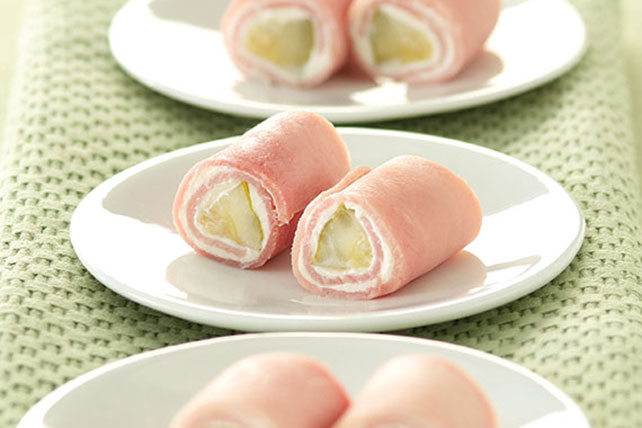
Is This Iowa’s Favorite Appetizer?
Who would have thought pickle wraps (a.k.a. pickle roll-ups) would be the hot food topic this holiday season? Of course, you don’t need a holiday to celebrate if you want to enjoy some “Iowa sushi,” as I explained to Des Moines Register reporter Courtney Crowder recently.
Here’s the great article from Courtney, along with my take on why pickle wraps are so undeniably Iowan (along with recipes, of course!)
Is This Iowa’s Favorite Appetizer?
Courtney Crowder , ccrowder@dmreg.com8:28 a.m. CST December 15, 2016
http://www.desmoinesregister.com/story/entertainment/dining/2016/12/14/iowas-favorite-appetizer/94676550/
My obsession with “Holiday Pickle Wraps” — also known as “Iowa Sushi” or “Lutheran Sushi” — began with a Facebook post.
Just before Thanksgiving, fellow reporter John Naughton posted a picture of a Hy-Vee display replete with cream cheese, pickles, dried beef and a sign noting that it was time for “Holiday Pickle Wraps.” Above the photo he wrote, “Sure sign you’re in Iowa.”
To me, the sign and its gathered foodstuffs might as well have been in a foreign language. Pickle wraps? Naughton’s post should have read: “A sure sign you’re not from Iowa.”
After living in the Hawkeye State for two years, I like to think I have at least a passing grasp on what is Iowan, but here I was simply gobsmacked by pickle wraps. What exactly are pickle wraps? Are these truly Iowan or just a quick appetizer Iowans are co-opting? And, most importantly, aren’t they incredibly salty?
“No, they’re not overly salty,” I was assured by Darcy Maulsby, lifelong Iowan and author of “A Culinary History of Iowa: Sweet Corn, Pork Tenderloins, Maid-Rites & More.”
“Pickle wraps are very, very popular in Iowa,” Maulsby added. “So many friends say pickle wraps are the first thing on the appetizer tray to go at their parties.”
Traditionally, a pickle wrap begins with a pickle (obviously), which is then slathered in cream cheese, wrapped in ham and cut into bite-sized pieces. However, there are variations on the general pickle wrap theme, Maulsby said. Some people sheathe the ham with a tortilla and others don’t use ham at all, instead opting for a dried beef encasement. Others make pickle wrap dip, where all the indigents of a pickle wrap are blended together and served with crackers.
“This is definitely a Midwestern thing,” Maulsby said. “You go to Arizona, Oklahoma, California, Michigan, they’ve never heard of a pickle wrap. Some Wisconsin and Minnesota people do know about pickle wraps, but I think Iowans should embrace this as our own, for sure.”
The exact genesis of the pickle wrap — or pickle roll-up as it is also called — is unknown, but Maulsby said the appetizer most likely originated as a modification of an old-world German recipe.
“I think of this as being in the same category as the fried breaded pork tenderloin, as far as its German-ness goes,” she said. “Anytime you have a German community or a place with a strong German heritage, you got pickles and red meat and that is two-thirds of a pickle wrap right there.”
As with its origins, the enduring legacy of the pickle wrap is up for grabs as well. So what is it that keeps Iowans coming back to the simplest of hors d’oeuvres?
“It’s the pickle wrap’s flavor sensation, and it’s a texture thing, too,” Maulsby said. “It does everything a good food should do: It’s interesting to the palate. The tang of the pickle plays nicely off of the smooth cream cheese and salty meat. The crunch of the pickle is in contrast to the creaminess of the cream cheese. As a food, it does so many things well.”
The best thing about the pickle wrap is that it is soeasy to make that even I, a cooking novice, feel confident in my abilities to master the roll-up. Simply slather, wrap and cut. But Maulsby urges chefs not to rest on their pickle wrap laurels, but to attempt their own variation on the classic roll-up. Take something conventional and make it your own!
“There are a lot of fun things you could do with pickle wraps,” Maulsby said, “and no one is going to get too worked up if you tweak the classic roll-up — at least I don’t think they will.”
Pickle wrap recipes
Here are culinary historian Darcy Maulsby’s favorite pickle wrap and pickle wrap dip recipes. To learn more about her work and other classically Iowan foodstuffs, check out her website at Darcymaulsby.com.
Classic Iowa pickle wraps
1 jar dill pickles
Ham slices
Cream cheese, softened
Lay the ham slices flat on a serving plate and pat dry. Spread with cream cheese. Place a pickle spear at one end of each slice and roll the slices into cylinders around the spears. Secure with toothpicks. Chill in refrigerator. Cut into bite-sized pieces.
Tortilla pickle-ham rolls
1 (32 ounce) jar dill pickles
1 (8 ounce) package cream cheese, softened and divided (make certain that the cream cheese is very soft for spreading)
1 pinch garlic powder, to taste (optional)
1 pound sliced cooked ham (I like to use honey ham)
6-inch flour tortillas
Mix the softened cream cheese with garlic powder (if using). Spread a thin layer of the cream cheese onto one side of a tortilla. Place 1 slice of ham over the cream cheese. Spread another layer of cream cheese over the ham. Roll a pickle up in the tortilla. Cover the roll with plastic wrap and chill for 2 hours (to make slicing easier). Remove the plastic wrap. Using a serrated knife, slice the roll into about 1-inch pieces or to desired size.

Dried beef pickle dip
1 package (3 ounces) dried beef, finely chopped
1 package (8 ounces) regular or reduced fat cream cheese
1/2 cup reduced fat sour cream
2 tablespoons chopped green onion
1/2 to 1 cup coarsely chopped dill pickles (not dill relish)
1/4 teaspoon pepper
Soften cream cheese and combine with remaining ingredients. Chill until serving. Serve with crackers or fresh vegetables.
— Dip recipe from the Iowa Beef Industry Council.
Savor more Iowa food history
Want more great recipes and Iowa food stories? Check out my top-selling “Culinary History of Iowa” book from The History Press, and order your signed copy today.
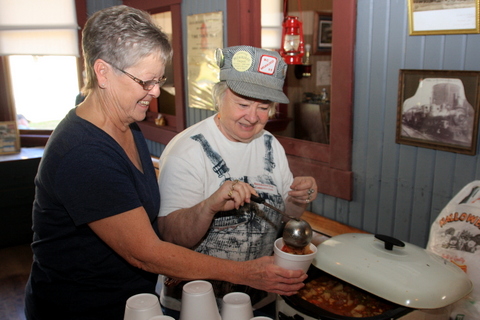
All Aboard! Rockwell City’s “Depot People” Offer a Taste of Iowa History
Eating like a hobo never tasted so good, at least when the “Depot People” are cooking. The savory aromas that emanate from the historic railroad depot in Rockwell City for one afternoon each fall signal that something good is coming down the line.
“I love this little museum and enjoy giving people a taste of the past,” said Carol Hupton of Rockwell City, president of the board of “Depot People” who have transformed the 1899 depot and freight shed into a museum.
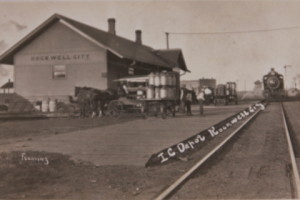
A train rolls into the Illinois Central Railroad depot in Rockwell City years ago.
During the annual fundraiser, which Hupton has helped with for the past six years, home cooking offers a feast at the Rockwell City depot a block north of the Calhoun County courthouse. Guests can dine on homemade hobo stew, hot dogs, homemade cookies, bars and more, with all proceeds going to restoration projects at the depot.
Saving the depot has been a labor of love for the Depot People, a group of about 25 people who want to preserve their community’s history. “There was a time when the depot was in danger of being torn down,” said Hupton, who has been volunteering with the depot museum for 10 years. “People don’t always realize the important role the railroad played to help Iowa and small towns like Rockwell City grow.”
The first railroad to arrive in Rockwell City was the Des Moines & Northern line, which was later taken over by the Chicago, Milwaukee & St. Paul Railway. The first passenger train rolled into town in 1881.
Rockwell City’s second railroad was the Illinois Central. Surveying the land between Fort Dodge and Rockwell City for this rail line began in 1899. Around 1903, the Newton and Northwestern Line, an interurban line, became the third rail line to Rockwell City. For decades, it brought passenger cars from Newton and Des Moines every two hours from 7 a.m. to 9 p.m.
During the heyday of the railroad, Rockwell City became a stop for multiple passenger trains and freight trains each day. Weary travelers could enjoy a meal at the nearby Hotel Brower or various restaurants in town.
In time, paved roads and interstate highways led to increased traffic from cars, pickup trucks and semi-trucks across Iowa and the nation, marking the end of an era for passenger trains. Railroad transportation itself changed as powerful diesel engines replaced the steam engines that once powered the many trains that rolled across the Iowa countryside. “Now the old depot here in town stands alone as a reminder of our history with the railroads,” Hupton said.
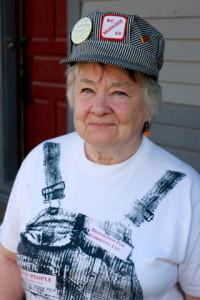 Sharing this history is important to Hupton and her fellow volunteers. The depot’s fundraising meal offers another way to encourage people of all ages to visit the museum. “Many kids don’t know anything about the history of the railroad in Rockwell City or other small Iowa towns,” Hupton said.
Sharing this history is important to Hupton and her fellow volunteers. The depot’s fundraising meal offers another way to encourage people of all ages to visit the museum. “Many kids don’t know anything about the history of the railroad in Rockwell City or other small Iowa towns,” Hupton said.
That’s why the Depot People have created historical exhibits in the depot, including vintage photos of the depot, to show the important role it once played in the community. A recreated hobo camp east of the freight shed also helps visitors learn how the railroad influenced people’s daily life in various ways.
The Depot People continue to apply for grants and host fundraisers with meals to preserve local railroad history. A summer car show allows car, truck and motorcycle fans to display their prized vehicles, while guests can dine on pulled pork sandwiches, potato chips, homemade desserts.
In the fall, the depot becomes an informal dining room where guests can enjoy a hearty bowl of homemade hobo stew, sugar cookies, salted nut roll bars and other goodies prepared by some of Rockwell City’s best cooks and depot supporters, including Maurine Zuetlau.
“Rockwell City’s depot is a landmark,” Hupton said. “We’ll continue to do what we can to preserve this local history.”
Savor more Iowa food history
Want more fun Iowa food stories and recipes? Check out my top-selling “Culinary History of Iowa” book from The History Press, and order your signed copy today.
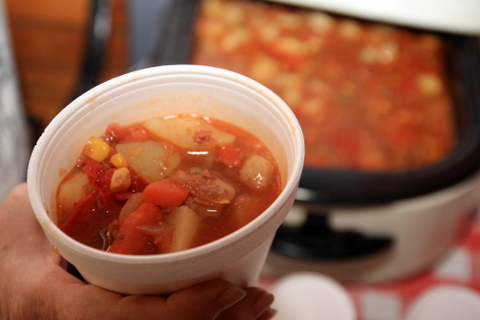
Hearty Hobo Stew from Iowa
Hearty Hobo Stew
4 pounds rump roast, cut up into cubes
Olive oil
2 cups diced celery
1 1 / 2 cups carrots, sliced
2 cups apple-cider vinegar
2 cups French onion condensed soup
3 to 4 cups potatoes, cubed and cooked
2 cans diced tomatoes
Beef stock (use as much as desired for the right consistency of stew)
Corn kernels, optional
Peas, optional
Brown the cubes of beef in olive oil. Combine beef with remaining ingredients. Place stew in roaster and cook until heated through.
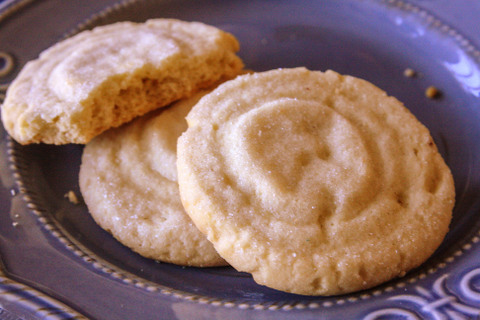
Homemade Sugar Cookies
World’s Best Sugar Cookies
These Amish sugar cookies come from Maurine Zuetlau of Rockwell City.
1 cup powdered sugar
1 cup granulated sugar
1 cup butter (can use half butter and half margarine)
1 cup vegetable oil
2 eggs
2 teaspoons vanilla
1 teaspoon salt
1 teaspoon cream of tartar
1 teaspoon baking soda
5 cups flour
Mix all ingredients. Roll dough into balls to form each cookie. Roll each dough ball in granulated sugar. Press down each ball with a glass dipped into granulated sugar. Bake cookies at 350 degrees for 13 to 15 minutes. Let cool on cookie sheet 2 to 3 minutes. Remove cookies and place on cooling rack.
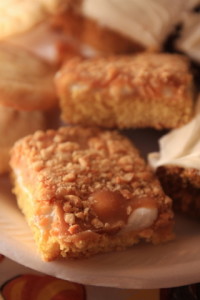
Salted Nut Roll Bars
Salted Nut Roll Bars
These tasty bars are reminiscent of salted nut roll candy bars and come from Maurine Zuetlau of Rockwell City.
1 package yellow cake mix
1 / 2 cup softened margarine
1 egg
3 cups mini marshmallows
2 / 3 cup white corn syrup
1 / 4 cup margarine
1 12-ounce package peanut butter chips
1 cup chopped, dry-roasted peanuts
Combine cake mix, 1 / 2 cup margarine and egg. Pat mixture into 9-inch by 13-inch pan. Bake at 350 degrees for 18 to 20 minutes. Cover bars with marshmallows. Return to oven for 2 to 3 minutes. (Marshmallows will puff up.) Cool.
Boil white corn syrup and 1 / 4 cup margarine. Remove from heat. Add peanut butter chips. Pour mixture over marshmallows and top with nuts. Cool completely, cut into bars.
P.S. Thanks for joining me. I’m glad you’re here.
@Copyright 2016 Darcy Maulsby & Co.
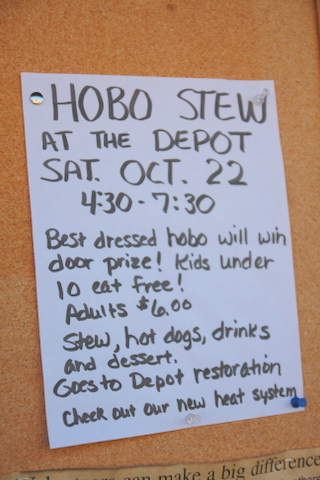
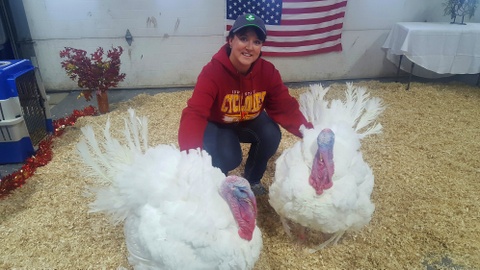
Iowa Turkeys Carry on National Thanksgiving Tradition
They strut around their little area of the farm with a certain air about them. Nothing ruffles their feathers. These two pristine, white Sac County turkeys (named Tater and Tot) are special—and they know it.
“We’re honored that the national Thanksgiving turkeys hailed from Iowa this year,” said Gretta Irwin, executive director of the Iowa Turkey Federation. “These turkeys are a symbol of plenty and are a great celebration of Iowa agriculture.”
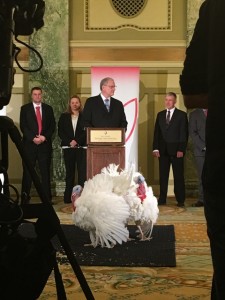
Tater and Tot make their Washington, D.C. media debut in the ballroom of the famous Willard Hotel on Nov. 22, 2016.
Through nearly seven decades, the President of the United States has received a turkey from the National Turkey Federation during Thanksgiving week. As part of the White House event, recent custom has the president “pardoning” the turkey, after noting the significance of a time of thanks for the nation’s many blessings and the opening of the holiday season.
Two turkeys are selected each year for this prestigious—if quirky—honor. One turkey functions as the “backup” in case the first turkey can’t complete its duties as the national Thanksgiving turkey. This year’s presidential turkeys hailed from Chris and Nicole Domino’s farm northwest of Early. The 42-pound male birds were born July 18 and were selected in August for their famous role.
“They had some of the best-looking feathers and the best personalities, because they are very calm,” said Chris Domino, a fourth-generation farmer who has raised turkeys for nine years. “They really stood out from the crowd.”
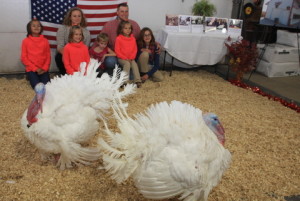
Chris and Nicole Domino and their five daughters raised Tater and Tot on their Sac County, Iowa, turkey farm.
Groomed for greatness
The presidential turkeys received plenty of personalized care during their months at the Domino’s farm, thanks to daughters Adrian, 13; Brianna, 10; Marissa, 8; Addison, 7; and Megan, 6. The male turkeys got their first taste of celebrity with the snacks they were offered. “We tried lettuce, cottage cheese and cooked eggs, but we found out the turkeys love dried meal worms and diced tomatoes,” Chris Domino said.
The birds enjoyed other perks, too, including dog toys. “They like playing with tugs and squeaky dog toys,” said Adrian Domino, who helped raise the birds with the help of her parents and sisters.
The five girls lavished attention on the turkeys and didn’t stop with special treats. They washed the birds and even played music for them. The first song to elicit a gobble from the turkeys? “Me, Too” by pop singer Meghan Trainor.
The turkeys got their first taste of fame on the morning of Nov. 18, when the Iowa Turkey Federation hosted a send-off for the birds. A small group of local and state media, turkey industry representatives and elected officials from Sioux City to Des Moines gathered in a shed at the Domino family’s farm to “meet” the celebrities and learn more about the Domino family’s farming tradition, which has spanned nearly a century.
“We highlight the family aspect of farming as we celebrate this fun, turkey-centered tradition,” Irwin said.
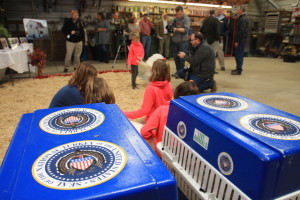
The official presidential turkey carriers are ready to transport Tater and Tot from their farm near Early, Iowa, to Washington, D.C.
Turkey tradition dates back to Truman administration
The turkeys left for Washington, D.C. in a van early in the week of Nov. 21. After arriving in the nation’s capital, they settled into their deluxe accommodations at the posh Willard Hotel just down the street from the White House.
Irwin and the Dominos watched as the Iowa turkeys basked in the spotlight during a high-profile media event at the Willard Hotel ballroom on Nov. 22. The big day arrived on Nov. 23, when President Obama bestowed names on the birds and issued his pardon for the turkeys, who were presented by National Turkey Federation Chairman John Reicks. The birds retired to Virginia Tech University, where they will live out their lives in comfort.
While some historians debate the origins of the presidential Thanksgiving turkey tradition, history is clear that the first presentation of a turkey by the National Turkey Federation occurred during President Truman’s administration.
Since then, Iowa has supplied seven of the Thanksgiving turkeys pardoned by various presidents. Prior presidential turkeys have hailed from Ellsworth, West Liberty, Dike and Story City. The birds have represented Iowa during the administrations of President Johnson (1964), President Ford (1976), President Reagan (1983 and 1988), President George Herbert Walker Bush (1991), George W. Bush (2008), and now Obama in 2016.
Congressman Steve King (R-Iowa) noted that 2016 marks the first time a presidential bird has come from his congressional district. He added that Benjamin Franklin wanted the turkey to be America’s national bird. “Turkey production is a form of value-added agriculture and reminds us that all new wealth comes from the land,” King said. “It’s a proud tradition that’s worth honoring as this country comes together for Thanksgiving.”
Savor more Iowa food history
Want more fun Iowa food stories and recipes? Check out my top-selling “Culinary History of Iowa” book from The History Press, and order your signed copy today.
P.S. Thanks for joining me. I’m glad you’re here.
@Copyright 2016 Darcy Maulsby & Co.
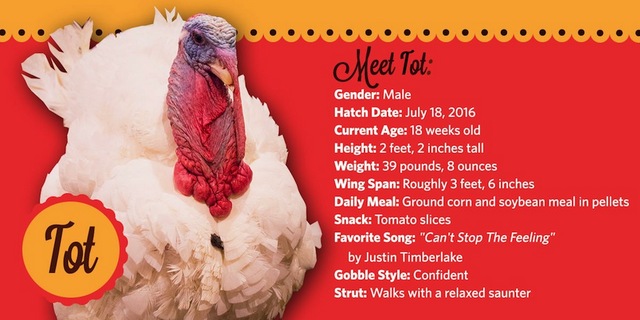
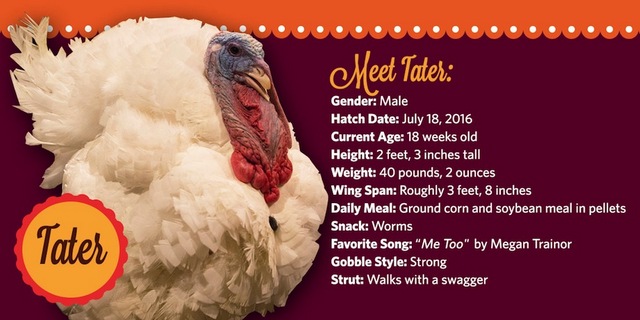
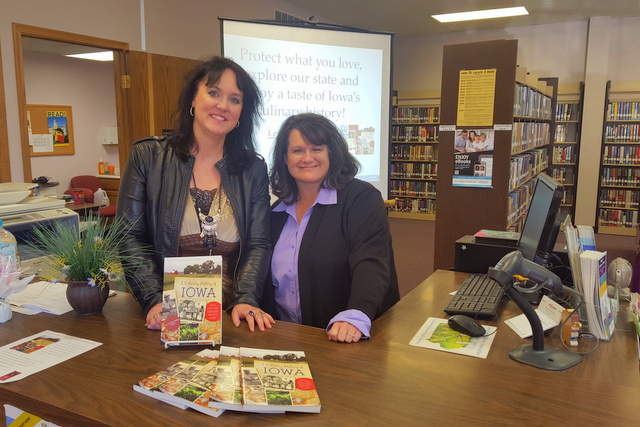
Iowa Eats! Why Radio Iowa, Newspapers and Libraries are Hungry for “A Culinary History of Iowa”
Everyone has an Iowa food story, even those doubters who sounded incredulous when I first proposed my idea for my “Culinary History of Iowa” book. Their amusement, followed by the inevitable question, “Iowa has a culinary history?” quickly dissolved into stories of Maid-Rites, potlucks and more.
The media, Iowa libraries and others across the state have really embraced these stories, too. I was honored to offer book programs and signings at the Ruthven Public Library and beautiful Kendall Young Public Library in Webster City. I was also pleased that the Webster City Freeman Journal ran a feature story on my book, at Pat Powers from KQWC Radio in Webster City interviewed me in a broadcast that has now popped up on Radio Iowa.
Need a fun read or a great gift idea? Click here to visit my online store, where you can purchase copies of “A Culinary History of Iowa,” a unique set of 15 vintage images from “A Culinary History of Iowa,” and my first book, “Calhoun County,” which shares the remarkable, illustrated history of small-town and rural Iowa through the eyes of those who lived it.
November 19th, 2016 by Ric Hanson
http://www.kjan.com/index.php?cat=3&paged=2
From pork tenderloins to sweet corn to Jell-o, a new book is out focused on Iowa foods and the flavors that make the state so delicious. The book, “A Culinary History of Iowa,” traces the popular tastes of Iowans through the years, according to author Darcy Dougherty Maulsby, of Lake City. “We do have great cuisine,” Maulsby says. “It’s funny. When the book came out, I had some people questioning, ‘Iowa has a culinary history?’ We sure do. I said, ‘Just starting thinking what defines Iowa food,’ and everybody always comes up with an answer.” Maulsby says she’s done research for the book by exploring all four corners of the state and everything in between.
“I’ve been working on it in bits and pieces for almost 20 years in my career as an ag journalist,” Maulsby says. “I’ve traveled the state and met with some of Iowa’s finest chefs and lots of great old-school farm cooks. I’ve seen the spectrum of really awesome Iowa food and it’s been so much fun to collect all of these stories and photos in one place.” Some might categorize it as a cook book but Maulsby says it’s more than that.
“It’s the story behind the things that define Iowa food,” Maulsby says. “Whether that’s Maid-Rites, Dutch letters from Pella, there’s so many fun stories, Laura Ingalls Wilder turns up in there, the Younkers Tea Room, all of these amazing traditions, meat lockers, sweet corn, all of the things that make Iowa food great.” Find the book at the Amazon and Barnes & Noble websites as well as at: www.darcymaulsby.com. (Radio Iowa)
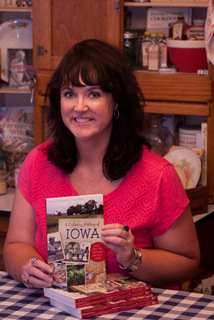
Darcy Maulsby is the author of “A Culinary History of Iowa,” which serves up stories, photos, recipes and more!
Iowa Eats: Maulsby pens book on the state’s culinary history
NOV 16, 2016
by ADRI SIETSTRA, Webster City Freeman Journal reporter
asietstra@freemanjournal.net
Author Darcy Maulsby will be bringing Iowa food stories to life during a free program Thursday evening at 6:30 p.m. at Kendall Young Library. The program will feature a cooking demonstration with book signing to follow.
“You’ll love this fun, fast-paced program filled with stories, rare vintage photos and surprising recipe tips. Be prepared to dig into the remarkable stories behind Iowa classics like Maid-Rites, breaded pork tenderloins, Iowans’ obsession with Jell-O, and our distinctive chili-and-cinnamon roll phenomenon,”said Maulsby. “I’ll also share practical, proven tips on how to preserve your own family’s history and food traditions.”
Maulsby, 43, is a self-described foodie and home cooking enthusiast from Lake City. She began baking and cooking in grade school while growing up on the farm. She entered many cooking contests at the Calhoun County Expo while a member of the Lake Creek Go-Getters 4-H Club.
“Food writing is a large part of my work as a small-business owner, freelance writer and marketing specialist who focuses on agriculture. I work with clients ranging from the National Pork Board to Farm News, where I often interview chefs and home cooks, create recipe pages and write feature stories that highlight the farm-to-fork connection,” said Maulsby.
In 2007, Maulsby completed the Master Food Preserver course through University of Illinois Extension. She earned her bachelor’s degree in journalism/mass communications and history from Iowa State University (ISU) and also earned her master’s degree in business administration from ISU.
Maulsby’s jams have won blue ribbons at the Iowa State Fair, and cookies have earned top honors at the Clay County Fair. She is also a certified Kansas City Barbecue Society judge.
Maulsby credits a variety of sources for the inspiration for her new book.
“The stories in “A Culinary History of Iowa” have come from the Iowa State Fair, as well as long-time restaurant owners, experienced farm cooks, candy shop owners and other foodies throughout Iowa,”Maulsby said.
Maulsby is excited to share some of Iowa’s culinary history with attendees Thursday evening.
“Everyone has a food story. Sometimes we don’t realize just how unique-and tantalizing-Iowa’s food traditions are. If you like to travel, you’ll walk away from this program inspired to explore Iowa, where you can sample flavors from around the globe without leaving the state,” said Maulsby. “If you have an appetite for adventure, you can’t do better than Iowa when it comes to history, agriculture and one-of-kind culinary experiences.”
Signed copies of her book “A Culinary History of Iowa” will be available for $24 a copy.
Celebrating great Iowa eats
LINDSAY ANDERSON, Kendall Young Librarian
 We Midwesterners are known far and wide for our excellent, down-home cuisine. Having only lived in Iowa for two years, I have already eaten enough to be amazed at Iowa’s particular brand of culinary delights.
We Midwesterners are known far and wide for our excellent, down-home cuisine. Having only lived in Iowa for two years, I have already eaten enough to be amazed at Iowa’s particular brand of culinary delights.
Have you ever wondered why Iowans cook – and eat – so well, and from where your signature recipes and food traditions originate? Iowa author and Lake City native, Darcy Maulsby, explores these and other food stories in her recently published book, Culinary History of Iowa. In it, she discusses everything from Maid-Rite classics to Iowan’s homemade cinnamon rolls (served with chili, of course). The Library is delighted to be hosting Maulsby at Kendall Young Library on Thursday, November 17 at 6:30pm for a presentation, book signing and cooking demonstration. Maulsby has been featured in the Iowa History Journal, Our Iowa magazine, Iowa Public Radio, and more. During Maulsby’s fun, interactive program, she will serve up fascinating tidbits related to more than 150 years of Iowa cuisine from all corners of the state. Attend this free event and discover how Iowa’s delectable cuisine is quintessentially Midwestern, grounded in its rich farming heritage and spiced with diverse ethnic influences.
On the Shelf
If all this talk of food has left you hungry, here are some titles that can help get some great, local Iowa eats cooking in your kitchen: The following cookbooks were recently added to the Library’s Genealogy Reference collection. While we do not allow these unique cookbooks to be checked out, you are welcome to browse them and make copies of any recipes that catch your eye.
The Famous Old Webster City Cook Book
Curated by The Ladies’ Aid Society of the Congregational Church in 1916, this cookbook boasts only “tried and tested” local recipes, including everything from waffles and pancakes, to salads and corn breads. A fun addition: the past page of this cookbook includes “Discoveries and Household Hints,” a delightful list of tips and tricks from some early 1900s kitchen experts.
4-H & Friends Cookbook
Assembled in honor of the Hamilton County 4-H program’s 70th anniversary in 1987, this nearly 400-page volume is painstakingly indexed, and boasts over 13 sections of recipes. Explore and discover some delightful gems; experiment with recipe choices ranging from “Shoo-Fly Cake” to “Gramma’s Hamburger Soup”.
St. Paul’s Lutheran Church Anniversary Cookbook
Compiled by the ALCW of St. Paul’s Lutheran Church of Williams, Iowa in 1987 to commemorate their 75th anniversary, this volume boasts more than 250 pages of hardy, time-tested eats that will satisfy your hunger and delight your taste buds. Try your hand at everything from “Buttermilk Cinnamon Bars,” to “Zucchini Date Pecan Loaf,” to “Highbrow Haddock.”
Try out these locally celebrated recipes for some delicious mealtime fun, and don’t forget to join us at the Library with Darcy Maulsby on Thursday, November 17 at 6:30pm for an unforgettable (not to mention delicious) journey into Iowa’s culinary past.
Order you copies today!
Click here to visit my online store, where you can purchase copies of “A Culinary History of Iowa,” a unique set of 15 vintage images from “A Culinary History of Iowa,” and my first book, “Calhoun County,” which shares the remarkable, illustrated history of small-town and rural Iowa through the eyes of those who lived it.
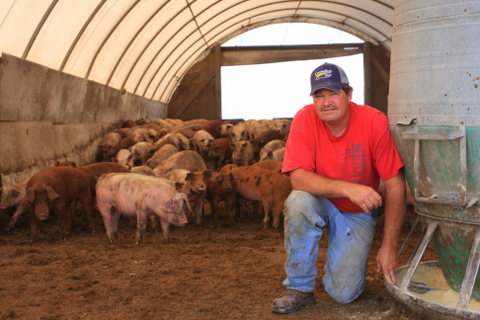
Voice of Reason: Iowa Pork Producer Dave Struthers Offers Top 10 Tips to Speak Up for Ag
With 40 years of hog production under his belt, Iowa pork producer Dave Struthers has seen it all, from pasture production to confinement barns to hoop barns. He’s also willing to help set the record straight about modern pork production and encourages other farmers to do the same.
“There’s a lot of misinformation out there about modern agriculture and livestock production,” said Struthers, a past president of the Iowa Pork Producers Association who farms near Collins. “Since people often don’t take the time to investigate or seek out more information on their own, it’s important for farmers to offer their perspective.”
Here are Struthers’ top 10 tips to help share agriculture’s story:
- Be a voice of reason. Who knows more about the realities of modern agriculture than the farmers who live it every day? “I tell people there are pros and cons of every swine production system,” said Struthers, who runs a farrow-to-finish operation along with a row-crop operation with his family. “I try to offer a practical point of view and provide a voice of reason.” Struthers takes a practical approach when non-farm audiences raise concerns about whether pigs are happy in confinement barns. “What tells me a pig is happy is when it’s healthy and growing,” he said.
- Say yes to opportunities. When the local newspaper, area radio station or major news outlet comes calling, be willing to go on the record, said Struthers, who raises approximately 250 sows and also has hoop barns. Along with participating in many media interviews, Struthers has appeared in the Humane Society of the United States’ documentary film “At the Fork” and has hosted international visitors on his farm. In addition, Struthers and his wife, Elaine, have helped with a bacon festival in San Francisco. “Don’t be afraid to engage,” he said. “It’s good to have these conversations and keep the lines of communication open.”
- Explain what motivates you. Farming is a multi-generation tradition for the Struthers family. “We’re in this for the long haul and care about our animals,” said Struthers, who has raised hogs since he was 9 years old.
- Share your practical experience. This extends from livestock care to nutrient management. “Just explain what you’ve seen and experienced on your farm,” said Struthers, who points out things that are interesting to non-farm audiences, such as the fact that he checks his animals daily and keeps daily observation records of the hogs. “I also explain that swine manure is a valuable asset on our farm,” said Struthers, whose family received the Wergin Good Farm Neighbor award this October. “I note that we soil test every three years and test the manure’s nutrient content, as needed, so fertility is managed properly on our farm.”
- Don’t hold anything back. Struthers is willing to explain the production practices he uses, from confinement barns to biosecurity protocols to tail docking. “Just be open and honest,” he said. Also, acknowledge that farms are complex biological systems, and there are no silver bullets. When asked about various production systems, Struthers addresses the challenges of livestock production in Iowa. “Pigs outdoors are wonderful when it’s 75 degrees and sunny. It’s not so good in freezing rain or snowstorms. Indoors we can create a consistent, comfortable environment and also provide good ventilation and air quality.”
- Be prepared for hot-button issues. Acknowledge that many people are concerned about manure management, water quality and antibiotic and hormone use in livestock production. Struthers explains to non-farm audiences that he only uses hormones when a sow is having trouble giving birth. “I use oxytocin, which is metabolized by the sow’s body and excreted in about 30 minutes,” he said. “I also note that this treatment is similar to Pitocin, the brand name of the hormone oxytocin that women sometimes use to have a baby.”
- Use analogies. Linking farm-specific information to examples that non-farm audiences can relate to is key. Consider antibiotic use in livestock. “I ask people, ‘If your child gets sick, are you going to cross your fingers and hope she gets better? No. You’re going to give her the medicine she needs.’ If antibiotics are required to help a sick pig, it would be contrary to animal well-being not to treat that animal.” Struthers also tells his audiences that all meat at the grocery store is antibiotic-free, since there are mandatory withdrawal times, plus packers conduct tissue tests to make sure the meat is antibiotic-free.
- Help others learn. Be willing to host farm tours, share information through social media and blogs, answer people’s questions and find other ways to help them learn. “Be proactive, and share what you know,” Struthers said. “Become a trusted source of information.”
- Be realistic. Having all the answers isn’t a prerequisite for sharing ag’s story. “If you can’t answer a question, be honest,” Struthers said. “Also, refer the person to Iowa State University, the Iowa Department of Agriculture or other resource that can provide the answer.” In addition, understand that everyone may not agree with your point of view about modern pork production practices, but that’s okay. “It’s progress when these people say, ‘You know, I can see why you’re doing what you’re doing,’” Struthers said.
- Focus on continuous improvement. Struthers is Pork Quality Assurance (PQA) Plus certified, plus his farm has been part of a site assessment to ensure that best-management practices are being followed. Struthers also works closely with his local veterinarian. “I’m always trying to learn more and improve our farming operation,” he said.
Finally, keep connecting with non-farm audiences, Struthers said. “The more you share agriculture’s story, the easier it gets. “
This originally appeared in Farm News, Oct. 2016.
Explore more rural Iowa history
Want to discover more stories and pictures that showcase the unique character of small-town and rural Iowa? Check out my top-selling “Calhoun County” book from Arcadia Publishing, and order your signed copy today.
P.S. Thanks for joining me. I’m glad you’re here.
@Copyright 2016 Darcy Maulsby & Co.
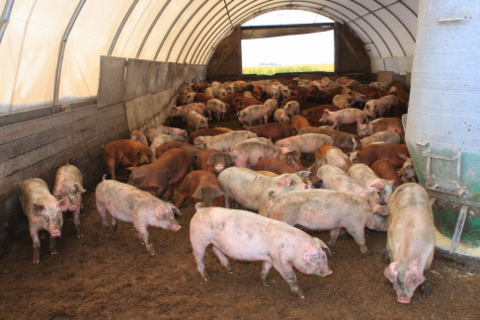
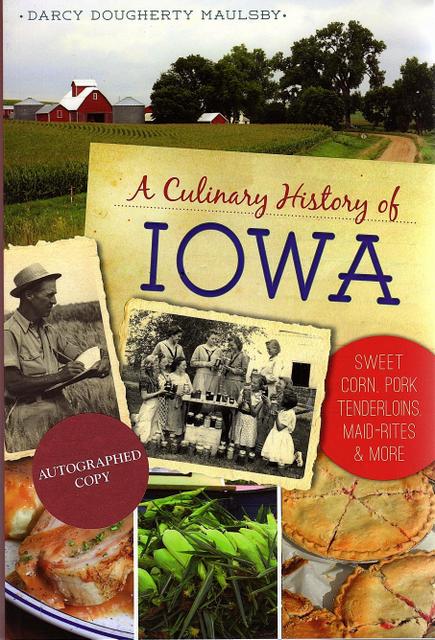
Talking Iowa Food and Culinary History on Iowa Public Radio
What do you think of when you think of Iowa food? Charity Nebbe explored Iowa’s amazing culinary history with me during “Talk of Iowa” on Iowa Public Radio recently, and you won’t believe all the incredible stories we covered in 20 minutes!
Listen to the complete “Talk of Iowa” interview about “A Culinary History of Iowa here.
Want to learn more about the book or its companion postcard packet of 15 vintage Iowa culinary history images? Check out my online store!

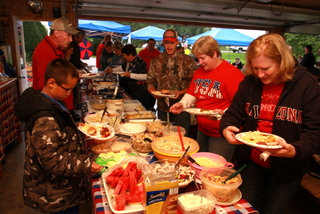
Remembering Sept. 11: Iowa Community’s Potluck Honors America
I wrote this story in 2014 for Farm News and wanted to share it again today on this 15th anniversary of the 9/11 tragedies. We must never forget, or take our freedoms for granted.
Ginger Tribby doesn’t do a lot of cooking. That doesn’t mean that incredible home-cooked food doesn’t abound, however, when she and her husband, Neal, host a potluck at their home each Sept. 11 to remember the day America changed forever.
“It’s about a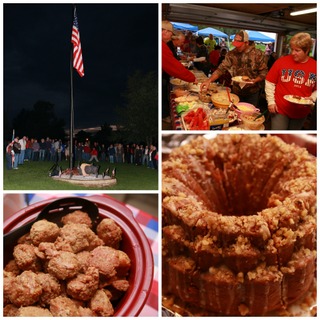 ppreciating our life, our freedom and all the blessings we have in America,” said Tribby, a retired Farm Bureau Financial Services employee.
ppreciating our life, our freedom and all the blessings we have in America,” said Tribby, a retired Farm Bureau Financial Services employee.
The Tribbys have hosted up to 200 guests for the annual Sept. 11 remembrance gathering—an impressive number for a community with about 110 people. The event offers a meaningful way to bring the community together, said Dorothy Gavin of St. Marys, who prepares a variety of dishes for the potluck. “We come together to honor those who perished, as well as the firefighters and first responders.”
The remembrance gathering started after Tribby, her husband, her sister Margie and brother-in-law Chuck were waylaid in Ireland following the attacks on Sept. 11, 2001. “We’d spent 10 days in Ireland celebrating our 25th anniversary,” Tribby recalled. “After we boarded a plane in Dublin on Sept. 11 to fly back to America, we heard there was going to be a slight delay.”
The passengers were later told that their flight had been cancelled due to the closing of U.S. air space. Amidst the fear and confusion, a fellow passenger with a cell phone was able to find out what was going on. “It was totally surreal,” said Tribby, who wasn’t able to return to the United States with her family until Sept. 15.
In 2002, the Tribbys decided to host a get-together on Sept. 11 to honor America. “It started as a small gathering,” Tribby said. “Then we thought maybe we should do this each year, so we have.”
The event has grown each year and includes people of all ages, from children to grandparents. Following an evening potluck meal featuring smoked pork loin, ham balls, cheesy potatoes and salads of all kinds, everyone heads to the dessert table loaded with cakes, bars, apple crisp and more. “The food is the best,” said Patty Gavin of St. Marys. “More importantly, Sept. 11 is a day that shouldn’t be forgotten.”
At sunset, guests gather in the Tribby’s back yard near the American flag to sing “America the Beautiful” and listen to a patriotic poem. “If that ceremony doesn’t make you tear up, nothing will,” said Steve Lininger, who travels 150 miles from Rock Port, Mo., to attend the annual gathering. “Sept. 11 changed the lives of everyone here. The remembrance gathering leaves a lasting impression on you.”
Savor more Iowa food history
Want more fun Iowa food stories and recipes? Check out my top-selling “Culinary History of Iowa” book from The History Press, and order your signed copy today.
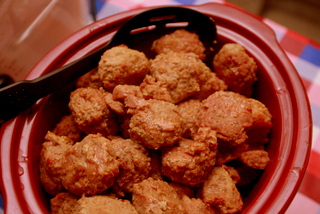
Ham Balls
This family favorite comes from Ginger Tribby’s mother, Ellen Dooley. Ginger and her sisters made a triple batch for this year’s Sept. 11 remembrance gathering.
1 pound ground ham
1 / 2 pound lean ground beef
1 / 2 pound lean ground pork
2 / 3 cup crackers, crushed
2 eggs
1 / 2 cup milk
1 / 2 cup finely chopped onions
1 / 2 teaspoon salt
1 / 4 teaspoon pepper
1 / 2 teaspoon liquid smoke
Syrup:
1 cup brown sugar
3 tablespoons vinegar
1 tablespoon water
1 teaspoon dry mustard
Combine all the ham ball ingredients. Shape into balls about the size of golf balls, and place in baking dish. Combine the syrup ingredients and set aside. Bake ham balls at 350 degrees for 30 minutes. Top the ham balls with syrup, and bake another 30 minutes.
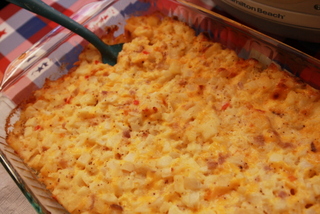
Cheesy Baked Hash Browns
This recipe from Joanne Gavin of St. Marys is always a hit at potlucks.
1 2-pound bag shredded hash browns
1 can cream of chicken soup
1 cup cheese (Velveeta or cheese in a can)
1 / 2 cup onions
1 / 2 cup peppers, diced
1 stick butter, softened
1 cup sour cream
Salt and pepper, to taste
Mix all ingredients together. Bake in an uncovered 9-inch by 13-inch dish at 325 degrees for 1 hour.
Macaroni Salad
This classic recipe is found in the “Great Home Cooking” cookbook compiled by members of the Immaculate Conception Parish in St. Marys.
3 cups macaroni (uncooked)
2 cups Miracle Whip salad dressing
2 / 3 cup sugar
2 cups cheddar cheese (shredded)
1 cup celery, diced
1 / 2 cup carrots (grated)
2 / 3 cup onion, diced
1 / 2 cup green pepper, diced
1 / 2 cup dried bacon bits
Mix Miracle Whip and sugar together with an electric mixer; set aside. Cook macaroni until tender. Drain and rinse in cold water; let cool. Combine Miracle Whip mixture with macaroni and all remaining ingredients. Refrigerate for two hours before serving. Makes 10 cups.
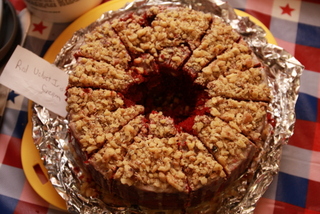
Rum Cake
This easy recipe from the Tribby’s friend Sheryl Reynolds of Des Moines tastes great with ice cream or whipped cream. It also freezes well. With a few minor adjustments (noted below the recipe here), it can be transformed into Red Velvet Irish Cream Cake.
1 cup chopped, toasted pecans or walnuts
1 15.25-ounce yellow cake mix
1 3.4-ounce instant vanilla pudding mix
4 eggs
1 / 2 cup cold milk
1 / 2 cup vegetable oil
1 / 2 cup Bacardi dark rum
Glaze
1 stick butter
1 / 4 cup water
1 cup sugar
1 / 2 cup Bacardi dark rum
Preheat oven to 325 degrees. Grease and flour a 12-cup Bundt pan. Sprinkle nuts on the bottom of pan. Combine all cake ingredients. Beat for 2 minutes on high with electric mixer. Pour into prepared pan. Bake for 1 hour. Cool in pan. Invert onto serving plate. Prick top with fork.
For glaze, combine butter, water and sugar. Boil 5 minutes, stir constantly. Remove from heat, and stir in rum. Note: the rum will cause steam, so be careful not to burn yourself. Drizzle glaze over top of cake. Use brush or spoon to put extra drippings of glaze on cake.
- To make Red Velvet Irish Cream Cake instead of Rum Cake, substitute 1 18.25-ounce box of red velvet cake mix instead of yellow cake mix. Also substitute 1 / 2 cup Irish Cream in the cake batter instead of rum. Follow all the same steps to prepare the cake. For the glaze, substitute 1 / 2 cup Irish Cream instead of the 1 / 2 cup rum. Follow all the same steps to prepare the glaze.
Slab Pie Bars
This recipe is a favorite of the Tribby’s neighbor, Holly Wiederin, who noted that it can be made with any berry or stone fruit. She likes to use pitted, tart cherries. This recipe makes one 17-inch by 12-inch sheet pan of bars.
For the crust:
5 cups all-purpose flour, divided
3 teaspoons coarse salt, divided
2 teaspoons sugar, divided
4 sticks cold unsalted butter, cut in to small pieces, divided
12 to 16 tablespoons ice water, divided
For the Slab Pie Bars:
All-purpose flour, for dusting
2 prepared crusts, from above
2 1 / 2 pounds (about 6 cups) fresh (or frozen, thawed & drained) berries, such as blackberries, blueberries, raspberries, or a combination
1 1 / 4 cups sugar
1 / 4 cup cornstarch
Juice of half a lemon (about 1 tablespoon)
1 / 4 teaspoon salt
2 tablespoon heavy cream
1 / 4 cup sanding sugar
For crust, process half of each of the flour, salt, and sugar in a food processor until combined. Add half of the butter. Pulse until mixture resembles coarse meal, about 10 seconds. With machine running, add about half of the ice water in a slow, steady stream just until dough comes together.
Turn dough out onto a piece of plastic wrap. Flatten dough, and shape into a rectangle; wrap in plastic. Refrigerate at least 1 hour or overnight. Repeat process with remaining ingredients – you need two discs of dough to make the Slab Pie Bars.
For the bars, preheat oven to 375 degrees. On a lightly floured surface, roll out a larger piece of dough to a 20-inch by 15-inch rectangle. Fit into a 17-inch by 12-inch rimmed baking sheet, pressing into corners. Pastry will hang over sides. Chill while assembling filling.
In a large bowl, stir together berries, sugar, cornstarch, lemon juice, and salt. Spread mixture over chilled pie shell.
On a lightly floured surface, roll out remaining piece of dough to an 18-inch by 13-inch rectangle; drape over filling. Fold edge of bottom dough over top dough. Pinch edges to seal. Prick top dough all over with a fork. Brush entire surface of pie with cream, and sprinkle with sanding sugar.
Bake until crust is golden brown and filling is bubbling, 40 to 55 minutes. Transfer to a wire rack, and let pie cool. Serve warm or at room temperature. Slab Pie Bars are best eaten the same day they are baked but can be kept at room temperature, loosely covered with plastic wrap, for up to two days. Slab Pie dough can be frozen for up to 1 month.
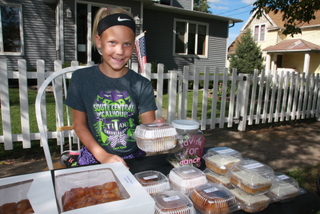
For the Love of Baking: Lake City’s Ellis Family Showcases Favorite Iowa Farm Recipes (Caramel Rolls, Pumpkin Bars and More!)
While some kids run lemonade stands, Tori Ellis, 11, sells homemade caramel rolls, pumpkins bars and more from a food stand in her family’s front yard along Main Street in Lake City. As she and her older sisters Aspen and Payton earn money for dance classes and dance competitions, they’re also learning the fine points of baking, using recipes passed on from their great-grandmother and grandmother.
“You k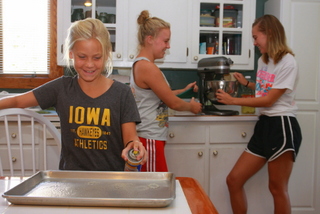 now it’s always good if you make it yourself,” said Aspen Ellis, 18, who is a senior at South Central Calhoun High School and reporter for the local FFA chapter.
now it’s always good if you make it yourself,” said Aspen Ellis, 18, who is a senior at South Central Calhoun High School and reporter for the local FFA chapter.
The Ellis girls learned to bake from their mother, Dannette (Smith) Ellis, who credits her mother, Jean, for teaching her learn how to cook. The Ellis family enjoy favorite recipes from the Smith and Schleisman sides of their family, including Grandma Loraine Schleisman’s famous caramel rolls and chocolate chip cookies. Other recipes, such as a creamy vanilla dessert and hearty beef stroganoff, are Dannette Ellis’ own creations. All have passed the Smith family’s “field test.”
“We take many of the things we make to the field at harvest or to the crew at our family’s hog barns,” said Dannette Ellis, whose girls get inspired by cooking shows like “Cake Boss” and “Good Eats” on TV.
Experimenting with new recipes is especially fun for Toi Ellis, who has sold homemade treats since she was seven years old. She’s glad her family bakes caramel rolls about every other week, since she has been known to sell 15 dozen in only three or four hours. “Baking makes the house smell like fall,” she said.
Savor more Iowa food history
Want more fun Iowa food stories and recipes? Check out my top-selling “Culinary History of Iowa” book from The History Press, and order your signed copy today.
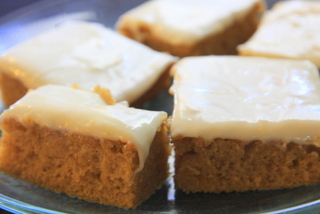
Dannette’s Pumpkin Bars
1 can pumpkin (or 2 cups fresh pumpkin)
2 cups flour
2 teaspoons baking powder
1 teaspoon baking soda
1 / 4 teaspoon salt
2 teaspoons cinnamon
2 cups granulated sugar
4 eggs
1 cup vegetable oil
1 teaspoon ground ginger
1 teaspoon pumpkin pie spice
Combine all ingredients. Bake in an 11-inch by 17-inch jellyroll pan for 20 minutes at 350 degrees. Frost with cream cheese frosting of your choice.
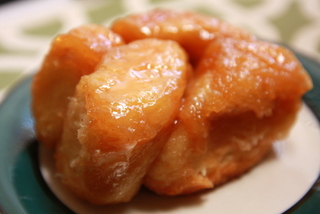
Grandma Schleisman’s Caramel Rolls
Don’t want to make caramel rolls? This recipe can also be used to make dinner rolls. Just don’t dip the knots of dough in a cinnamon-sugar mixture, and skip the caramel sauce.
2 cups granulated sugar
4 eggs
2 cups shortening or lard
3 teaspoons salt
1 cup mashed potatoes
1 teaspoon granulated sugar
4 packages yeast (2 1 / 4 teaspoons per package)
1 cup warm water, plus 5 cups warm water (or use potato water)
5 to 10 pounds flour
2 1 / 2 sticks of butter or margarine, melted
3 to 4 cups granulated sugar
Cinnamon, to taste
Mix together sugar, eggs, shortening, salt and mashed potatoes. (The Ellis family uses their large stand mixer for this process.) Set mixture aside.
Mix together 1 cup water, 1 teaspoon sugar and yeast in a glass bowl. Let mixture rise about 15 minutes.
Begin adding flour and water to mixture of sugar, eggs, shortening, salt and mashed potatoes. Add flour (a large spoonful at a time) and alternate with the 5 cups of warm water. Keep mixing and adding flour and water. When about half the water has been added to the dough, add the yeast water mixture. Continue to add flour and water until the water is gone and the dough begins to form a ball.
Turn the dough onto a floured surface. Knead the dough until it’s nice and smooth. Divide dough into two balls; place each one into large bowls that have been lightly greased with oil. Then cover each bowl with a damp towel.
Place bowls of dough in the warmest part of the house to let dough rise until it has doubled in size. Punch dough down. Cover bowls with a damp towel again. Let dough double in size once again.
Make the caramel topping (see recipe below). Pour caramel into 9-inch by 13-inch pans. (The caramel roll recipe makes 5 to 6 dozen caramel rolls. You can get 12 rolls into one 9-inch by 13-inch pan.)
In a bowl, combine the sugar and cinnamon. Melt butter or margarine in a separate bowl.
Punch down dough. Take a handful of dough and roll on the countertop. Form a strip of dough; then dip into the margarine and then into the cinnamon sugar. Tie dough into a knot. Place each knot on top of the caramel in the pan. Continue until dough is gone.
Bake each pan of rolls about 25 minutes, or until rolls are dark brown. The rolls need to be fairly dark on top in order for the middles of the rolls to bake properly. Cover rolls halfway through baking so the tops don’t get too dark. When baking is complete, let the rolls cool on the counter for about 2 minutes. Put tinfoil on top and flip pan over to invert. The pan should come off with no problem.
Let rolls cool. Store in air-tight plastic containers. Makes 5 to 6 dozen rolls.
Caramel Topping
2 / 3 cup brown sugar
1 / 4 cup margarine (Imperial brand margarine works well)
2 tablespoons corn syrup
Combine all ingredients in a sauce pan. Cook 1 minute, and then stir. Then cook 1 more minute. Pour mixture in bottoms of 9-inch by 13-inch pans.
Grandma Schleisman’s Famous Chocolate Chip Cookies
A mixture of shortening and butter help these cookies achieve the right shape and texture when baking.
1 1/3 cups shortening and butter (combine a mixture of roughly half butter and half shortening)
1 cup granulated sugar
1 cup brown sugar
2 eggs
2 teaspoons vanilla
3 cups flour
1 teaspoon baking soda
1 teaspoon salt
1 / 2 cup chocolate chips
Using a mixer, combine all ingredients except chocolate chips. Stir in chocolate chips by hand. Chill dough in refrigerator for 1 hour. Scoop out balls of dough onto baking stone or pan. Bake about 12 minutes at 350 degrees, or until cookies are nicely browned. Store cookies in air-tight container. These cookies freeze well, too.
Dannette’s Sugar Cookies
Almond extract adds a special flavor to these cookies, which work best when they are rolled out thin and are not overbaked.
1 cup margarine
1 1 / 2 cups powdered sugar
1 egg
1 teaspoon vanilla
1 / 2 teaspoon almond extract
2 1 / 2 cups flour
1 teaspoon baking soda
1 teaspoon cream of tartar
Cream margarine, powdered sugar, egg, vanilla and almond extract together until smooth. Add dry ingredients until well blended. Chill dough at least two hours, or overnight. Roll out dough on a floured surface to desired thickness. Cut dough with cookie cutters of your choice. Bake cookies on greased cookie sheet or baking stone at 350 degrees until bottoms and sides of cookies start to brown. Frost when cool.
Dannette’s Sugar Cookie Frosting
1 / 2 stick margarine
Dash of milk for right consistency
1 teaspoon almond extract
Powdered sugar (enough to make a nice, smooth frosting to coat the cookies)
Combine all ingredients together. Frost cookies, as desired.
Dannette’s Vanilla Dessert
This takes great on a crisp fall day with a warm cup of coffee.
1 / 2 cup walnuts
1 cup flour
1 / 2 cup margarine, melted
1 8-ounce contained whipped topping, reserve 1 cup
1 cup powdered sugar
1 8-ounce package cream cheese, softened
2 3-ounce packages instant pudding (any flavor is fine, although the Ellis family prefers vanilla)
3 cups milk
Chopped walnuts for garnish
For the first layer, combine walnuts, flour and margarine. Pat mixture into the bottom of a 9-inch by 13-inch pan. Bake 10 minutes at 375 degrees, and cool completely.
For the second layer, cream together 1 cup whipped topping, powdered sugar and cream cheese. Mix well. Spread over first layer in pan; chill.
For the third layer, combine pudding mixes and milk. Beat until thick. Pour pudding over second layer in pan; chill.
For the fourth layer, spread the remaining whipped topping over the third layer. Garnish with chopped walnuts. Refrigerate.
Dannette’s Beef Stroganoff
The Ellis family likes to serve this hearty stroganoff over mashed potatoes and cooked noodles.
2 pounds ground beef
1 / 2 cup chopped onion
3 cloves garlic
1 teaspoon beef bouillon
Salt, pepper, onion salt, garlic, meat tenderizer, to taste
1 can cream of mushroom soup
1 soup can of milk
1 / 2 cup sour cream
Brown ground beef in skillet. Drain fat. Add onion, garlic, beef bouillon, and seasonings. Cook until browned. Add cream of mushroom soup and milk. Cook for 5 minutes. When ready to serve, add sour cream.
I originally wrote this article for Farm News, Ft. Dodge, Iowa.

“A Culinary History of Iowa” Satisfies: Iowa History Journal Book Review
This terrific review of my latest book, “A Culinary History of Iowa: Sweet Corn, Pork Tenderloins, Maid-Rites and More,” from The History Press appeared in the September/October issue of Iowa History Journal. Enjoy!
Also, if you’d like to get your own signed copy of “A Culinary History of Iowa” or would like to send signed copies as gifts, click here to visit my online store. I appreciate your support for authors and Iowa-based small business!
Iowa has a long and substantial culinary history; far deeper than corn and pigs that are so often associated with our farm-rich state. “A Culinary History of Iowa,” written by Darcy Dougherty Maulsby, delves deep into its past, tracing as far back as the pioneer settlers for the story of food in Iowa.
From well-known names such as the Graziano Brothers, Blue Bunny ice cream and Maytag Blue Cheese, to hidden gems found in the most unexpected places, Iowa’s food culture is incredibly varied. As the book’s subtitle “Sweet Corn, Pork Tenderloins, Maid-Rites and More” suggests, there are unique flavors to be discovered across the state.
The book is an excellent primer on the roots of Iowa farmland, as well as current trends. Beginning with an overview of Iowa’s agricultural value and its products from American Indian traditions through the Great Depression and beyond, Maulsby concisely writes how Iowa history is tied to food creation, proliferation and consumption. The Iowa State Fair is a section unto itself, which befits the food-centric and beloved affair. A diverse gallery of local events (country fairs, sweet corn festivals) and modern confabs (Baconfest) are the beneficiaries of profiles, as well.
Finally, the book devotes space to the many long-established restaurants that can be found almost anywhere in Iowa; each with its own story to tell. It’s always fascinating to see history through a different lens, and Iowa’s culinary exploits definitely shine throughout these pages.
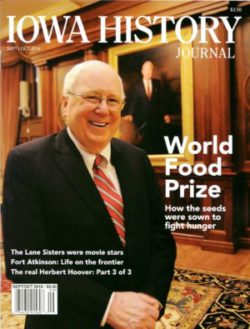 Iowa has been influenced by many cultures in a variety of ways, but nowhere does that cultural melting pot shine so bright as in the kitchen. Polish, Swedish, German, Dutch and other culinary traditions are highlighted across multiple chapters in an exploration of what it means to be an immigrant in Iowa and how such cultures blend to create a far more ethnically diverse cuisine than many realize. Of all the observations and stories in the book, these wonderfully inclusive stories are among my favorites.
Iowa has been influenced by many cultures in a variety of ways, but nowhere does that cultural melting pot shine so bright as in the kitchen. Polish, Swedish, German, Dutch and other culinary traditions are highlighted across multiple chapters in an exploration of what it means to be an immigrant in Iowa and how such cultures blend to create a far more ethnically diverse cuisine than many realize. Of all the observations and stories in the book, these wonderfully inclusive stories are among my favorites.
This eclectic mixture of historical tidbits, social observations, vintage photos and delicious recipes provides just the right ingredients for a delightful reading experience. Maulsby, an Iowa native and lifelong food lover, has an obvious passion for her topic, and it pays off in this compact and charming book. She has worked across the state and Midwest for such diverse entities as Progressive Farmer magazine and the Iowa Turkey Federation.
Maulsby has written in many publications about Iowa food, and it’s clear that it is a labor of love and a collaborative labor as Maulsby solicited tales input from all across the state for the juiciest food-related tales and locations. Even those who are well acquainted with Iowa food lore are sure to find something new and interesting.
Ideal for anyone with a love of food history and particularly those with a Midwestern heart, this book has so many interesting tales, morsels of trivia and personal anecdotes that it feels as though the book should be twice as long. Go on an adventure with this fun, fascinating and tasty tale of culinary traditions that weave through Iowa’s past and present. Just be sure you have a snack handy.
(Julie Goodrich is a graduate of the University of Iowa and the University of Wisconsin. She works at Beaverdale Books in Des Moines, in addition to holding down a full-time job because she loves books.)


